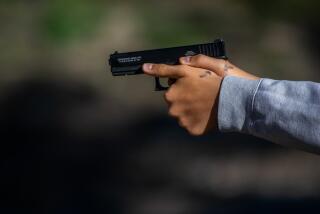Disabled Get Training in Self-Defense
- Share via
FRESNO — Unlike most college physical education courses, the one Al Smith teaches at Fresno City College every Wednesday morning is deadly serious.
Smith is a martial arts instructor who teaches one class a week at the college, helping disabled students learn how to defend themselves.
“You and I can’t imagine a disabled person being mugged, but it happens every day,” Smith said. “They need to know how to protect themselves.”
Smith’s students suffer from handicaps, ranging from physical to psychological, that make them what muggers consider easy prey.
“A mugger will see someone in a wheelchair or a blind person or someone who for various reasons is not well coordinated and figure he’ll have an easy time getting their money,” Smith said. “We show these people how to keep that from happening.”
Smith’s instruction is done in the school’s gym, where the students have the benefit of mats to cushion their falls, but it still gets pretty rough at times.
“You can’t just show them how to knock somebody down, they have to actually take a person down in class so they’ll know how much force it takes,” Smith said.
No-Nonsense Instructions
There is no nonsense to Smith’s instruction on how the disabled students should defend themselves.
“We have them go for the eyes and groin, two places that will discourage a mugger almost immediately,” Smith said.
Tom Pratt, a diabetic double amputee confined to a wheelchair, is one of the more than 20 students taking Smith’s class this semester. He said he joined the class because he was mugged in his wheelchair once.
“I wanted to learn how to keep from being a victim,” Pratt said. “I am now beginning to feel that I can take care of myself in any situation.”
Smith’s instruction is designed to give disabled victims a chance to get away if they are attacked.
“We review methods by which the students can protect themselves and remove themselves from situations of danger,” Smith said. “Basically, we’re teaching them how to survive an attack and run or wheel away from those who might target a handicapped person.”
The class is part of the school’s adaptive physical education program designed especially for disabled students. To enroll in the program, a student must be certified by the state as disabled.
Smith’s students range from Pratt, whose legs are missing, to men and women who have vision problems, motor function problems, speech problems and disabilities from strokes or other medical problems.
The students show up for the self-defense class in various attire, from shorts and sweat shirts to skirts and sweaters.
“We encourage them to attend at least some of the classes in street clothes because that’s how they are usually dressed and they are most likely to be attacked wearing street clothes,” Smith said. “This will show them the limitations they face in certain types of clothing and in some cases may convince them not to wear certain types of clothing.
“It’s pretty hard to knee an attacker in the groin if you’re wearing a tight skirt,” Smith said.
Besides the actual self-defense knowledge, Smith said, the course also helps build self-confidence.
“A lot of people who are disabled have a low self-image,” he said. “Once we show them they can learn to handle themselves just as well as anyone else, their self-image usually improves.”
More to Read
Sign up for Essential California
The most important California stories and recommendations in your inbox every morning.
You may occasionally receive promotional content from the Los Angeles Times.













